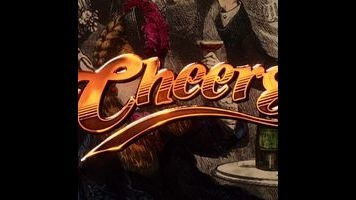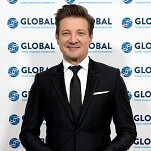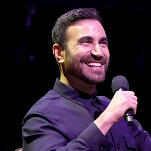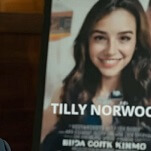The Fight To End All Fights begins like so many before it: with a case of mutual deception. Wearing his finest burgundy blazer, Sam saunters into the bar, fresh from an interview with Boston Magazine for its upcoming “20 Most Eligible Bachelors” issue. Naturally, he’s kept this information from Diane. Alas, his feeble diversionary tactic—a story about a dog walking on its hind legs—doesn’t work, and their 8 millionth fight about the same subjects ensues. Feeling betrayed, Diane reverts to her default strategy by insulting Sam’s intelligence. He fires back with his weapon of choice, a white lie about telling the reporter he only has eyes for Diane. She pretends to believe him, if only because it makes her look like the bigger person. Here we have the essence of everything that is mismatched about these two: He’ll lie about what he’s done, she’ll lie about how she feels about it.
Sam knows Diane’s suspicions will soon get the best of her, and so he instantly starts to hatch a scheme to make it up to her. “It’s going to take a lot more than music and candlelit dinner to shut her up,” he reasons. The solution? Get an artist to paint her picture. Cliff suggests an artist, Phillip Semenko, whose mail he delivers. Cliff figures he must be good since he just received a check for more than $28,000. (Those 300 watt light bulb sure do come in handy, don’t they?) It is indeed a romantic gesture, and it’s especially thoughtful considering Diane’s long-standing interest in art. Alas, what follows is more reminiscent of “The Gift Of The Magi” than a happy rom-com.
By the time Semenko, resplendent in an Arapaho ceremonial tunic, stops by the bar to meet Sam, he and Diane have already had one of their biggest rows yet—ending with a near-death by phone cord. Sam seems unfazed by the fight, and presses on with his portrait scheme. Semenko stops by the bar and is instantly unimpressed by Sam, whom he calls “a nightmarish product of our floundering American educational system.” Almost as soon as Semenko opens his mouth, it’s inevitable that he’ll have a thing for Diane. Christopher Lloyd plays the role just right; he’s ridiculous but not a cartoon, and damned if he doesn’t rock that tunic.
For all its predictability, the Sam-Diane-Semenko love triangle is entirely convincing. It’s a perfect storm, in a way: Diane’s always been a bit of a sucker for pretentious creative types, and Sam’s always felt insecure about his intellectual capabilities. Ironic, then, that Sam’s attempt to woo Diane almost pushes her into the arms of another man. (Maybe he should have bought her a set of hair combs instead?) As the first episode ends, Diane defies Sam by posing for Semenko, and, it seems likely, a whole lot more.
So it’s interesting that Diane doesn’t give in to Semenko’s blunt attempt at seduction (“I make love to everything I paint,” he declares) even though he obviously offers her something she’s not getting from Sam. Diane believes that, despite his objects to her posing for Semenko, Sam will be won over by the artists’ “atrabilious yet not a bit lugubrious” portrait of her. As much as she butts heads with Sam, her rationalization of the deception sounds a whole lot like him, doesn’t it? For his part, Semenko predicts doom for Sam and Diane’s relationship.
Sam ropes Diane back in with some juvenile taunts (the armpit farts were a nice touch, weren’t they?) and from there, the argument descends into Three Stooges-esque nose-pinching, face-slapping farce. The slapstick is sublimely well-executed, but it also has a troubling subtext, one that the show is brave to acknowledge. When Diane expresses her shock over the violence, Sam fires back that he hadn’t hit her as hard as he wanted to. It sounds less like a defense of his behavior than a confession to even darker emotions.
Once again, Sam seems emboldened and invigorated by the truth, ordering Diane to leave the bar. “You’re about to cross a very dangerous line,” she warns. And she’s right: It does feel like a Rubicon has been crossed, because we’ve never seen things get quite so ugly between these two before, and it’s clear their love-hate relationship has curdled into something crueler. Finally, after to close to an hour—make that a year plus an hour—of back and forth, Diane finally leaves. We watch as the hem of her red skirt floats up the stairs. Seconds later, she starts making her way back down, pauses, then vanishes for good. Is there a more theatrical moment in Cheers history? It almost feels like the end to the second act of a musical, the dramatic breakup before the third-act reconciliation.
But that’s not what comes next. Instead, the episode ends on a thrillingly ambiguous moment. Sam unwraps Semenko’s painting. We half expect a Philistine reaction along the lines of, “Hey, I coulda painted that.” Instead, he utters a single syllable, one that’s loaded with the possibility that Diane—and maybe the rest of us—have underestimated Sam all along: “Wow.” He could be speaking for all of us, couldn’t he?
I’ve spent most of my time talking about Sam and Diane’s perfectly orchestrated swan song, but really everything about these two episodes is phenomenal, from Norm’s gripes about the Hungry Hiefer to Coach’s doomed picnic to Carla and Cliff’s spirited debate about Burt Reynolds’ love life. And I could probably write a thousand words alone on the small miracle of that “previously on Cheers” update, brought to us by Coach. There’s just wonderful stuff crammed into every nook and cranny of these episodes, and somehow the jokes seem sharper and more crisply timed than ever. It’s like watching Cheers while wearing 3-D glasses. Even if I get pedantic, I find it hard to muster anything but admiration for this hour of television. Surely I’m not the only one.
Ryan McGee: I love how the show clears the bar for the final confrontation in a way that feels organic but also illuminates character. Coach’s repeated requests for help with the annual bar picnic feels like a stock comic setpiece: Here’s a guy looking for volunteers yet ends up doing everything himself. However, he turns the tables on the patrons by playing upon their perception of his intellect. Here’s a guy they can’t believe could pull a fast one on them. Apparently, they forgot all about “Pick A Con, Any Con.”
With Coach having suckered everyone into helping, the stage is set (literally and figuratively, as Meredith already pointed out) for a scene that pays off two years of tension (romantic and dramatic) between Sam and Diane. And while ensuing episodes will probably prove me wrong, I doubt that Ted Danson and Shelly Long were ever better than they were in this extended two-character dance. It’s a marvel of performance that matches the marvel of the writing: The fight itself is paced wonderfully, with pockets of humor, deep melancholy, and slapstick silliness all working in concert with one another. Meanwhile, Semenko’s painting (or should I say Chekhov’s painting?) sits there, still. Sometimes it’s between them, sometimes it’s in the background, but it’s omnipresent all the same. It gains presence and power throughout the scene, until the urge to scream “Just open it!” becomes unbearable. I’ll let Noel speak more to the “Wow” moment itself, since I know that’s one of his favorite television moments of all time. But it hit me like a ton of bricks, and fittingly ended a season that featured much heavier themes than I recall from watching as a child.
Phil Dyess-Nugent: I’m not sure whether this is the most affecting of all the times that Sam and Diane have had the argument that will “end them forever”—until that last word. It’s a perfect ending that’s in keeping with an episode built around the formation of what, as Meredith says, is a believable romantic triangle, one in which none of the participants gets what he or she wants. Except maybe, in the most spiteful way possible, for Phillip Semenko: He really does want his painting to tear Sam and Diane apart, and he succeeds, even if the final moment tells us that he’s wrong to think that they shouldn’t be together because Sam could never appreciate what Diane has inspired in an artist. Semenko is just the trigger that forces both of them to admit to themselves, and each other, a lot of things they’ve been holding back. There is, for instance, that heartbreaking moment when Diane says that she thinks Sam enjoys hurting her, a moment that stings that much worse for the audience because it only comes after Sam has admitted that it’s the truth.
Little moments like that—both the insight into the characters, and the double-edged way of using it—say a lot about why Cheers was the most sophisticated sitcom on the air in its day. The use of black-and-white and the absence of a laugh track during Coach’s briefing on what happened in the first part put this show right at the center of 1984’s network-sitcom avant-garde. There’s only one big mistake in this whole two-parter, but it’s a dilly: I can’t believe they actually showed us a glimpse of Semenko’s painting. Even if it didn’t look like a Walter Keane that had been left out in the rain overnight, this is a screw-up on a par with Steven Spielberg recutting Close Encounters Of The Third Kind to include a view of the inside of the spacecraft. I think the ending would be a thousand times more haunting if we were left to imagine what Sam was reacting to.
Noel Murray: The funny thing is, Phil, my memory of this episode for years was that we didn’t see the painting; I had it my head as a prime example of the Pulp Fiction “What’s in the suitcase?” ambiguity. It wasn’t until I watched again a few years ago that I discovered that there’s actually a good long shot of that canvas. Which is strange, I agree. But I don’t think the painting is all that bad, really. Maybe that’s because I’ve been projecting Sam’s “wow” onto that space all this time.
And what about that “wow,” huh? As Ryan has said, it’s easily one of my Top 10 TV moments of all time, because it’s so unexpected, and says so much about Sam Malone and where he is at this point in his life, since meeting Diane. Early in this two-parter, as Diane is reacting brusquely to Semenko before she knows who he is, it’s obvious that her time at Cheers has changed her, making her harder and more mistrustful. (Sam’s constant lying can’t help in that regard.) But in some ways, Sam has been affected by Diane even more profoundly, for better and worse. Diane recognizes what she’s done to him when he preemptively freaks out about his “fork with soup” mistake. (“You just called me a babbling idiot, and you’re criticizing yourself?” he says, confused.) Sam, though, seems more capable than Diane of compartmentalizing their relationship. To him, sometimes they fight, and sometimes they’re all lovey-dovey. Just because he yells at her in front of the entire bar and earns their (rather scary) applause for laying down the law, all macho-like, that doesn’t mean he doesn’t still love her. And it doesn’t mean that he hasn’t been paying attention during all their time together. I love the way Sam stops Diane before she leaves the bar, saying “this is it” and “goodbye” almost sweetly. And then… “wow.”
Donna Bowman: Sam’s honesty, and Diane’s claim that honesty is what she wants, come crashing together in nuclear fashion in this finale. My heart was in my throat as Sam digs that crater deeper and deeper: “I’m glad I didn’t tell her,” he exults regarding his failure to mention Diane to the magazine, “because it would make me look whipped!” As Diane looks more and more stricken, Sam twists the knife by reminding her it’s what she said she wanted: “This is just me being honest here.”
But it’s not like Diane should have a clear conscience. “In the last six months you’ve come so far, made such progress!” she patronizes in part two, and Sam rightly protests that she’s talking as if he’s a trained chimp. “No chimp alive could keep up with you!” Diane breezily jokes, and the worst part is that she doesn’t seem to realize that the rules of how to preserve their relationship have changed. And as the stakes get higher, neither of them can stop in order to step back from the brink. That slap fight and nose-twist sequence is a masterpiece—both funny and legitimately humiliating for the two of them. When Sam dismisses Diane’s offense by saying he didn’t hit her that hard, and she asks what that means, he hisses: “It means not as hard as I wanted to.” There’s no veneer of civilization left to provide a cushion between word and act. And then when we see Diane’s legs on the steps stop, turn, and wait, a moment with no music or laughter behind it, only our collective held breath —well, that may be the most heartbreak the American sitcom could ever hope to produce. To quote Sam: “Wow.”
Todd VanDerWerff: God, this episode breaks my heart, and a part of me likes that we’re putting these reviews on hiatus for the time being. I know it’s a TV show, so there’s a need to contrive a way for Diane to end up back in the bar, because that’s just how TV works. But there really is a sense of permanence at the end of this episode that American television is going to have to cheat, just a bit, because that’s how the system works. (When Diane finally leaves the show for good, it’s a good episode, but it’s nothing like this.) I talked a few weeks ago about how this show really captured that feeling of being in a fight in a relationship that seems good one moment, then abruptly takes a shift into the dark and terrifying, as the both of you don’t really know what ground you’re standing on anymore. I love the moment when Diane tries to leave, and Sam keeps making faces at her, almost daring her to dive even deeper into being juvenile with him, and she can’t resist the bait, even if she knows it’s the beginning of the end. That this is all so funny while it’s also being so genuinely sad shows just how well Cheers—and only a few other sitcoms ever, really—could capture the pathos inherent in being trapped in a series of dysfunctional relationships. Diane wants to leave, and so does Sam, but the gravitational pull between them is just too strong.
Erik Adams: For all the work the show did in strengthening its ensemble across the last 22 episodes, season two is still the season of Sam and Diane, the unwinding of everything that was wound up by season one. And so it’s only appropriate that “I’ll Be Seeing You” ends with these two characters, alone in the bar—and, eventually, Sam, all by his lonesome, just like we found him at the top of “Give Me A Ring Sometime.” All Diane leaves him with is that painting. It’s her honest view of the relationship filtered through Semenko, the opposite of the facile, lovey-dovey velvet grotesquerie Sam commissioned. It’s crushing that these two, once so in love, require third parties to express how differently they see things.
However, it’s nice to know that the show will be back. After all, that gravitational pull Todd mentions is located within Cheers, and while it will pull Diane back in a way that’s more strained than we may prefer, it’ll also pull Sam and Coach and Carla and Norm and Cliff back, too. Sam’s lost a great love, but he still has a lot to live for (not that he’ll be showing it the next time we see him). A TV show’s need to re-establish the status quo before the start of the next episode rings false in some regards, but it is reflective of the manner in which life marches on through slap fights, through picnics, and through breakups. Until that march resumes, the bar is closed.
Stray observations:
NM: One last note on that amazing final scene, which to me is the best of the big Sam-Diane episode-ending conversations. I’ve mentioned before how alarming and of-its-time the actual physical violence between Sam and Diane has been in these first two seasons, and here it erupts in a slap-fight, which is meant to be funny—and kind of is, in context. But as weird as the physicality seems in 2012, it also lends a real tension to that scene, because there’s a genuine sense of danger. It’s only defused by the dialogue, which is so sparkling. (“The fat braying ass would,” indeed.)
MB: Cliff really shines in this episode. He weighs in on the rumors about Burt Reynolds’ love life with the earnestness and self-assurance of a literary scholar, and when Sam mentions an article in TV Guide about the cutest sitcom kids, he weighs in, “Interesting reading, that.” This just slays me.
RM: Two moments that absolutely slew me, in a different way: Diane’s line “Sometimes he hurts me and seems to like it,” and Sam’s near meltdown at mistakenly alluding to the use of a fork while eating soup. This pair fundamentally damaged each other to the point where we should almost be thankful they managed to extricate themselves from each other’s lives. (Then again, those that have seen the third season knows this is absolutely awful for Sam in the short-term.)
PDN: It took me a few minutes to figure out who “Burt and Sally” were. I thought it was “Burt and Loni” by now, but I guess that particular horror show was still in the out-of-town tryouts stage. Truly, 1984 was a more innocent time.
MB: Sam also has one of his greatest lines ever with “Nuclear war would be bad news.” So true, Sam. So true.
NM: Coach’s suggestion to Sam that he try and salvage his relationship with Diane by having sex is one of the sweetest things I’ve ever heard.
PDN: Among other things, this episode stands as a time capsule of the moment when Christopher Lloyd—thanks to Reverend Jim, Buckaroo Banzai, and the last great malevolent pre-Worf Klingon—was one of the coolest actors alive. I don’t want to say that playing one too many living cartoon characters was about to set him on a road where he would seem less like an eccentric character actor than a random collections of twitches and tics—but it’s nice to recall that he once had a sexual presence.
PDN: On the Buckaroo Banzai tip: Sam’s outfit for his interview—the long red jacket with patches on the elbows and extra-long, skinny tie, all of which seems even more elongated thanks to his second-story hair, along with the blue-and-black socks we get to see when Diane is throttling him—are the peak of early-’80s geek chic. I’m guessing the reporter was cute.
PDN: When Diane asks Semenko what he’s doing in the bar, and he says, “Up to now, fondly remembering my bout with jaundice,” and you can hear the dead silence from the audience for a few seconds before Diane, realizing that he’s making a funny, erupts with an eager-to-please fake laugh: Any bets on whether that was fully scripted, a desperate save on Shelley Long’s part, or a combination of the two?
NM: Okay, one more last observation on that last scene. The way Shelley Long works around the audience’s laughter when Diane and Sam have each other by the nose is a prime example of how shooting a sitcom live can be a boon. I’d love to show that to everyone who sniffs about the awfulness of the “laugh track.”
NM: Is it me, or is there way too much head on the beers in nearly every shot in these episodes?
NM: The Hungry Heifer is referenced for the first time! (But not the last.)
TV: After this, I skipped to the season three première, just to remind myself what happens. Man, Frasier’s debut is a great character introduction. When you see it, it’s no surprise that guy stuck around for the next two decades.
What you said:
kfpeters has a gripe about the acoustics at Cheers:
“Norman’s Conquest is one of those many episodes of ‘Cheers’ where you have to suspend reality that Norm and Cliff can talk back and forth across the bar and hear each other perfectly fine, but the woman they’re talking about is sitting six feet behind Norm is completely oblivious they’re talking about her.”
Ajax digs through the most obscure portions of Diane’s vocabulary (an obscurity eventually clarified by thomasrhys):
“In a couple episodes she will describe someone as ‘squamulous’, which even the Internet has been unable to provide a definition for. That’s pretty impressive in this day and age.”
Walrus notes a shift we’ll see as we dig deeper into the series:
“In rewatching the show these past few months, I have thought a lot about when the change occurs – from character-driven ‘early Cheers’ to the pure-punchline-based version – and concluded it happens in two waves, both probably too obvious to mention. One is with Colasanto’s diminished presence in the last several episodes of Season Three and untimely death before the season wrapped. The show had already become noticeably slicker than when it began, but so long as Coach remained, there was a wistful and very human quality at its heart, which somehow carried over into the other characters and their storylines. (Season Three pulls back quite a bit from the darker areas explored in Season Two, but it still has episodes like ‘Coach in Love’ and the Sam/Diane ping-pong episode that feel of a piece with the first two seasons.)
The second major shift is with Long’s departure. Even though the ensemble dynamic was thrown off (as explained above), and the writers were headed increasingly in the almost cartoonish direction the show would fully embrace during the Rebecca years, Long herself seemed determined to inject some note of pathos and humanity into her character, and her acting could bring out some of the best in Danson (as in the final episode/final scene of Season Five, which does manage to return to that earlier wistful feeling (otherwise lacking by that point)). I found it interesting how, in the ballet episode (I think Season Five), everything is played as broadly as possible.. until Long’s brief, sad beat in the final shot – seemingly an afterthought, unexpectedly moving… but also tonally inconsistent with the way Danson, Grammer, etc. were acting by that point.”
Next week: Our reviewers are getting out of Boston for a few months to work on their own, personal summer TV Club Classic watching lists. Thanks for sticking around to talk about this fantastic season of Cheers!








































